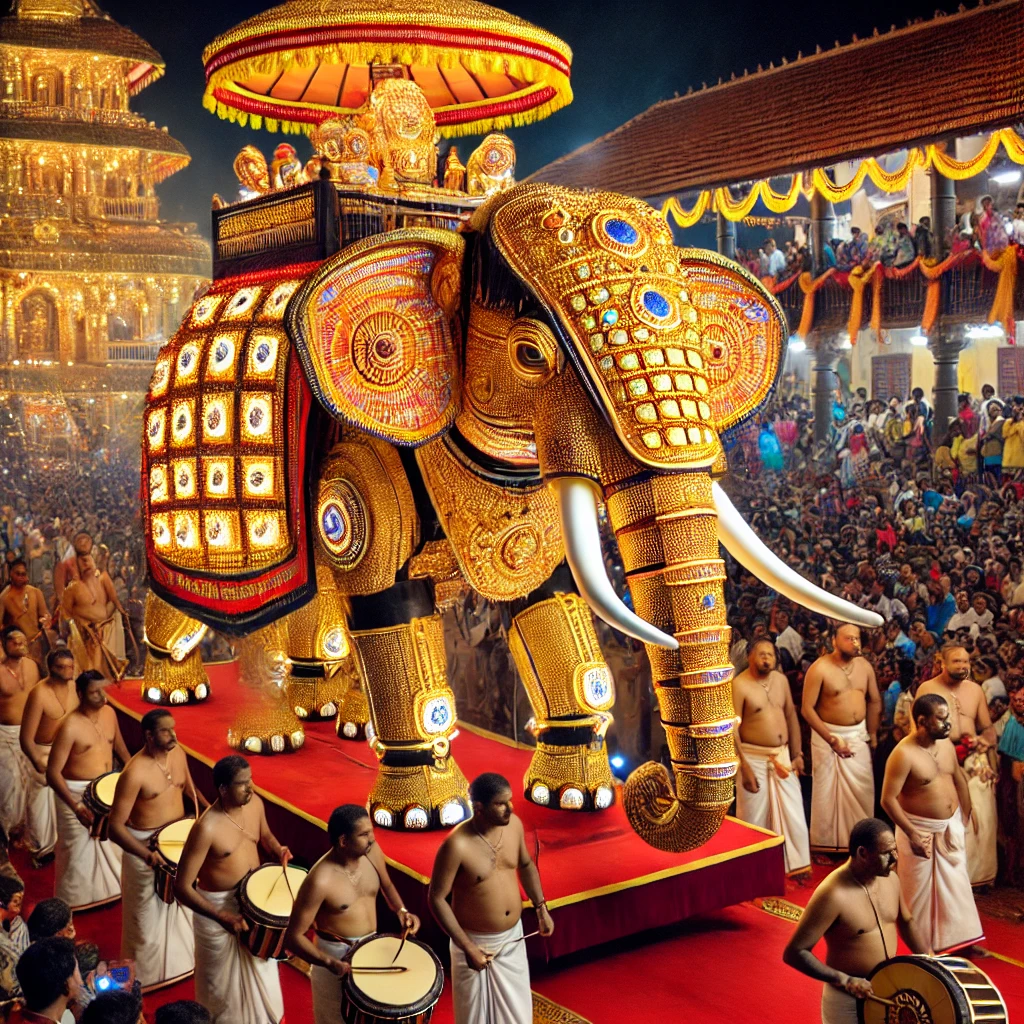In a groundbreaking initiative that blends technology with tradition, the Kombara Sreekrishna Swami Temple in Kerala has introduced a mechanical elephant named Kombara Kannan, a significant step towards ethical temple festivities. This development, supported by PETA India and Grammy-nominated sitarist Anoushka Shankar, highlights the growing movement towards animal-friendly temple rituals. As part of our commitment at SR Study, we explore how this innovation aligns with modern ethics while preserving rich cultural traditions.
Significance of Elephants in Kerala Temples
Elephants hold a sacred place in Kerala temple traditions, symbolizing wisdom, strength, and prosperity. They are often seen in temple processions, festivals, and religious ceremonies, adding grandeur to spiritual celebrations. However, the practice of using live elephants has raised ethical and safety concerns, leading to the introduction of mechanical alternatives like Kombara Kannan.
Challenges of Using Live Elephants in Temples
Despite their traditional significance, the use of live elephants in temples presents several challenges:
Animal Welfare Concerns
Live elephants often endure harsh captivity, rigorous training, and physical restrictions. Constant exposure to loud sounds and crowds can cause severe psychological distress, leading to aggression and health issues.
Safety Hazards
There have been numerous instances where agitated elephants have caused accidents, endangering the lives of devotees and mahouts. A mechanical alternative eliminates these risks, ensuring a safer and more controlled environment.
Legal and Ethical Challenges
Growing awareness of animal rights and wildlife conservation has led to stricter regulations regarding elephant ownership and treatment. Ethical concerns have prompted many temples to seek alternative solutions to maintain their traditions.
Kombara Kannan: The Future of Temple Festivities
Innovative Design & Features
Kombara Kannan, the newly introduced mechanical elephant, is a marvel of modern engineering. Built using fiber, steel, and rubber materials, this 800-kilogram, three-meter-tall structure is equipped with five motors, allowing it to mimic realistic movements like trunk swaying and walking.
The Role of PETA India & Anoushka Shankar
This initiative is part of a larger effort led by PETA India and Anoushka Shankar, who advocate for animal-free temple traditions. Their contribution reflects a commitment to ethical worship practices without compromising cultural values.
Successful Implementation
Inspired by the Irinjadappilly Sri Krishna Temple, which first adopted a robotic elephant, Kombara Sreekrishna Swami Temple embraced this innovation, paving the way for other temples to follow.
Advantages of Using Mechanical Elephants in Temples
1. Preserving Tradition Ethically
A mechanical elephant ensures that temple rituals retain their grandeur while adhering to modern ethical standards.
2. Enhancing Safety
Unlike live elephants, robotic elephants do not pose any threat to devotees, mahouts, or festival attendees, making celebrations more secure.
3. Promoting Animal Welfare
Replacing live elephants with mechanical alternatives protects elephants from captivity and distress, allowing them to thrive in their natural habitats.
4. Cost-Effective & Sustainable
While maintaining a live elephant is expensive and resource-intensive, a mechanical elephant offers a long-term, maintenance-friendly solution that reduces overall costs.
Community Response & The Future of Temple Elephants
The introduction of Kombara Kannan has received widespread appreciation from animal rights activists, devotees, and temple authorities. This shift towards animal-friendly worship sets an example for other temples across India to adopt ethical, sustainable practices.
SR Study’s Perspective
At SR Study, we believe in promoting innovations that respect both tradition and ethics. The adoption of mechanical elephants in temples is a remarkable step towards modernizing religious practices while ensuring animal welfare. We encourage further awareness and discussions on ethical reforms in Indian traditions, aligning culture with compassion and sustainability.
Conclusion
The mechanical elephant revolution is a testament to how technology and tradition can coexist harmoniously. By embracing alternatives like Kombara Kannan, temples can continue their revered practices without harming animals. As more institutions recognize the importance of ethical cultural adaptations, this initiative stands as a beacon of progressive change in Indian temple traditions.
For more insightful discussions on ethical innovations and cultural reforms, stay connected with SR Study.
For a visual representation of elephants in cultural contexts, you might find this video insightful:



